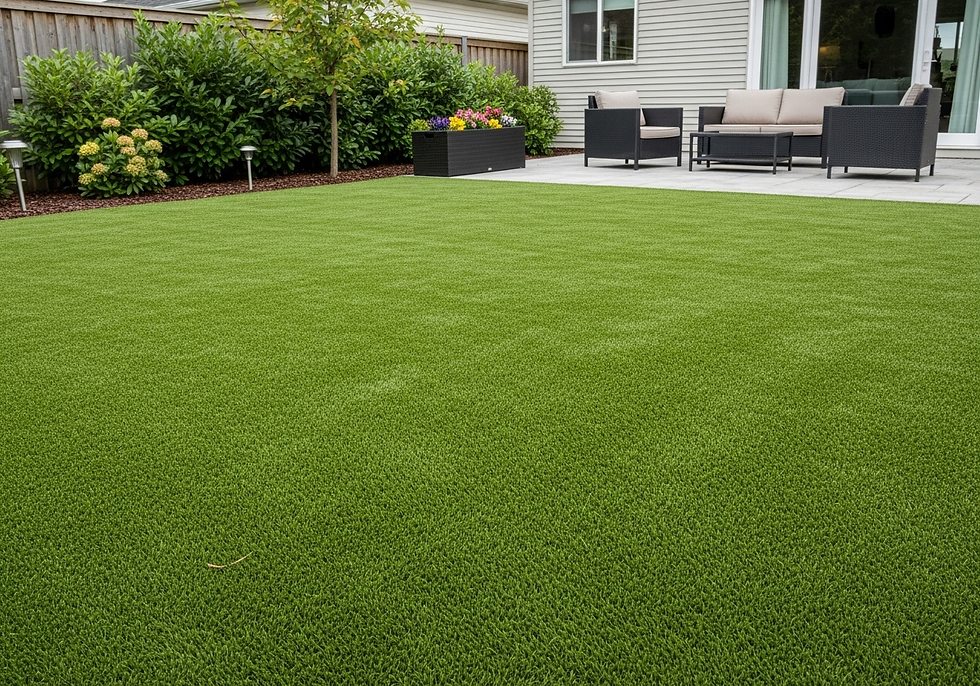The Artificial synthetic turf Disaster: How Your 'Low-Maintenance' Lawn Is Cooking Your Yard?
- Dennis Asis

- Oct 5
- 4 min read

Artificial synthetic turf has gained popularity among homeowners eager for a lush, green lawn without the hassle of maintenance. However, this convenience hides several risks that could harm your yard and the environment. Let’s uncover the potential dangers of artificial turf and understand why your low-maintenance lawn might not be as safe as it appears.

The Allure of Artificial synthetic turf
Artificial turf offers an attractive solution for homeowners who want a beautiful lawn without the traditional upkeep. It eliminates tasks like mowing, watering, and fertilizing. Visualize a perfectly manicured lawn year-round without patches of brown grass or muddy shoes.
Yet, this appealing ease comes at a cost. The materials that comprise artificial turf can introduce significant risks to your yard and the environment. For example, synthetic turf's production processes contribute significantly to fossil fuel usage, with estimates indicating that producing one square yard of turf can require gallons of petroleum.

The Environmental Impact
The environmental effects of artificial turf are a major concern. Most artificial grass is made from petroleum-derived materials like polyethylene and polypropylene. The production process not only consumes fossil fuels but also emits greenhouse gases.
Furthermore, artificial turf does not provide the biodiversity that natural grass supports. By switching to synthetic grass, you may be reducing local wildlife populations and eliminating valuable ecological benefits.

Heat Retention and Urban Heat Islands
Artificial turf is notorious for its heat retention. On a sunny day, the temperature of artificial grass can spike above 150°F (65°C), creating a hazardous environment for children and pets.
This heat retention also contributes to the urban heat island effect. Urban areas with synthetic grass can be several degrees warmer than their surrounding environments. This increased heat can heighten heat-related health risks in communities and boost energy requirements for air conditioning.

Chemical Concerns
To enhance the durability and aesthetic of artificial turf, various chemicals are often used. These include heavy metals and toxic substances that can seep into the soil and groundwater. For instance, studies have found benzothiazoles, a class of chemicals used in synthetic turf, in the leachate from artificial grass fields.
The infill materials used, such as crumb rubber, are particularly concerning. Research has linked prolonged exposure to crumb rubber with issues like respiratory problems and skin irritations.

Maintenance Myths
Although marketed as low-maintenance, artificial turf requires ongoing care. Regular cleaning is essential to keep the surface sanitary, which involves removing debris, pet waste, and organic matter. Some cleaning routines use harsh chemicals that may further pollute the environment.
Moreover, artificial grass can develop mold and mildew if neglected. Artificial turf could harbor harmful microorganisms without proper maintenance. This can lead to unpleasant odors and an unsafe playing surface.

The Cost Factor
While the initial cost of artificial turf might be appealing, the long-term costs can be significant. Synthetic grass typically lasts between 10 to 15 years, after which it must be replaced. The average cost for replacing artificial turf ranges from $8 to $15 per square foot, depending on the quality.
Moreover, the environmental costs of production and disposal are often ignored. Since synthetic materials are not biodegradable, they contribute to ongoing landfill waste. According to a study by the Green Sports Alliance, millions of pounds of artificial turf waste end up in landfills each year, where they remain for centuries.

Alternatives to Artificial Turf
If you seek a low-maintenance lawn that is kinder to the environment, consider more sustainable options. Native grasses and drought-resistant plants can create a stunning landscape while conserving water and supporting local wildlife populations.
Furthermore, xeriscaping is a fantastic approach that focuses on low-water-use plants and minimal irrigation. Through this method, you can design a vibrant garden that flourishes in various conditions while contributing to water conservation efforts.
Final Thoughts
While artificial turf might seem like a hassle-free answer for a perfect lawn, the hidden dangers associated with it deserve serious consideration. From negative environmental impacts to health concerns, the risks tied to artificial turf can outweigh the apparent benefits.
Before switching to synthetic grass, weigh the long-term implications for both your yard and the ecosystem. Opting for natural landscaping methods can create a healthier, sustainable outdoor space that benefits you and the environment.
Putting in a bit of extra effort to maintain a natural lawn can enhance the beauty and longevity of your yard for years to come.






Comments